Building A Training-Practice
Latest date of Revision, Up-date, and/or Addition is 10-18-99
In this chapter you will learn the vital role and the importance that a well designed and constructed practice and training track brings to your racing career and success. The guidelines, type of planning, and route a champion must follow to become highly successful. And the attitudes and behaviors the potential champion must grow, develop, and evolve into to accomplish his "Racing Dreams".
In this chapter, as in all chapters, as you read, take notes in your book. Also, "Hi-lite" any or all areas you find helpful, beneficial, and/or useful for advancing your "Racing Mind", your "Thinking Process", and how you "Apply It". In this way, you will be able to do both: study and review this material at a much faster rate, and be able to re-locate and/or recall this material at a much faster rate at later dates. Pay careful attention to all BOLD Print and Underlined Words.
Before we start this chapter let me leave you with this success clue; "Your Thinking Process is your best Success Weapon! Become a great student - always be willing to learn. How you think becomes your direction of growth and development and success in life. The choices you make dictate the life you live." Become the leader, not the follower. Direct the Pathway others must follow.
I wonder why so many good riders never recognize the need for a well planned and constructed practice and training track to assist them in reaching their racing goals. "Problem Recognition" is truly a major weakness for most people, especially riders. This weak link, without a doubt, has cost many good rider, and potentially great riders, their championships and eventually their careers. This is a hard lesson to learn. It is a problem in our race school, as well. It shouldn't be, but it is! Why is that? Maybe this chapter can change, influence, and upgrade their "Thinking Process". Learning to recognize problems before they get started is a real advantage in reaching new goals and heights. But just what is, "Problem Recognition"? Let's start at the beginning.
The first rule of racing deals with "Problem Recognition". It states; "Always evaluate your performance for weak areas so you can improve them". Does this statement sound familiar? "The top rider is always compelled to evaluate his performance so he can apply what he has learned. So he doesn't repeat the problem. And so he can escapes into the solutions." So let me make a vulgar statement that is a true today and it way yesterday; "You need a well planned and constructed practice and training to properly and purposefully develop your skill levels. The misconception in the above is that you don't need a lot of land to do so; you only need a small amount of land to do so.
At some point in your MX racing career development you will decide to build your own Outdoor National (NX), Grand Prix (GP), Arenacross (AX), or Supercross (SX) race track. If you are going to be and stay competitive with the top riders of today you must have your own track to practice on and to stay highly proficient.
The first and for most theme is any track design is; "Safety"! You must be able to train and practice with a minimum "Risk Of Injury". Yet, the practice and training track must be technical. What is meant by "Technical"? Technical, in its broadest since, means
The racing skill levels required of today's riders demand accurate and constant practice on tracks designed and build with stadium difficulty, procession, and technical complexities. You may, at first thought, think that building a SX track would be relatively easy and simple. It is not! It is very demanding and requires your absolute attention, creativity, and patients. Accurate and precise planning is the key. Drawing the track out in detail is the first planning step.
If this is your first race track may I suggest that before you start with yours you first help or work for one of the major track building company as; Stadium Dirt Designs. You will discover, real fast, what to do and what not to do. What comes first, second, and so on. In what order or sequence. What type of dirt to use. How many loads or cubic yards of dirt it takes to build each obstacle. What slope angles are required for take off ramps, landing ramps, and when to use or change those angles. How to calculate slope angles. How to tell, show, and mark off obstacles so that heavy equipment operators can build exactly what the plans, diagrams, or drawings call for. How much dirt cost per load or cubic yard. How to slope or plan water drainage for the land where the track is being build. How to plan and build an underground watering system for your track. Zoning for the land. What type of heavy equipment is needed? How much it cost per hour. How to keep and maintain the track after it is build.
As you can start to understand from the above, planning and building a track to the level that today's competition demands takes time and money if it is to be done right and benefit you to its highest potential for your success in racing. It is, in any way, shape, or form, not easy. In fact, it is difficult, but worthwhile if done correctly.
Where do we start first? A suitable piece of land is needed first. You may ask, how much land? Today's stadium SX tracks are approximately 300' x 300' or one football field in size. Actually, I have found that you can build an excellent training and practice track on 1.5 acre for NX or SX. But how does a practice Supercross track fix into the total picture of motocross racing?
Part of the total picture deal with mixing or cross training Supercross and outdoor cross together in your riding training program. Mixing or cross training both Supercross and outdoor cross is what the top ten riders are presently doing. That is, during the Supercross season, the first practice moto is on an outdoor track. And the second moto in on the Supercross practice track.
During the outdoor season the practice moto order is reversed. That is, the Supercross is practiced first. And the second practice moto is on the outdoor track.
What does this riding cross training accomplish? To answer this question correctly you need to understand what each type of race training develops and demands from its rider.
Supercross lacks the speed found on the outdoor track but it is filled with technical and complicated obstacles. Each obstacle is demanding and requires correct execution in order to enter the next. With obstacles always following, requires the rider to always be constantly be alert, both for the next up-coming obstacles and for other riders. One after another, always one after another, there is no time to rest or let you guard down. Twenty minutes of constant high energy levels of alertness.
So, negotiating high densities of both track obstacles and other riders determine your race results. In fact how well you perform the next obstacle is directly influenced by how well you performed the obstacle before it. Supercross demands that the rider make as few to no mistakes to keep his speed up during each lap. Hence, Supercross teaches the rider perfection and precision. At no time during each lap can a rider relax, sit back, and coast a few seconds. All obstacles, like jumps, straight-a-way, whoop-de-do's, or corner, are hocked together. How well you do one is dependent on how well the did the one before it. That is to say, how well you do the straight-away is dependent upon how well you performed the previous corner, jump, whoop-de-do, or table top. Supercross teaches you the attitude of mistake free racing.
Outdoor cross allows a more relaxed style. It is not as demanding. Don't get me wrong, it is demanding, but to a much less extend that Supercross. Outdoor racing is at a much greater or higher speed level over Supercross. Outdoor motos are longer and requires a much longer level of endurance energy. Supercross demands a combination of a 2/3 endurance energy level and remaining 1/3 power energy level. Supercross motos are about one half the time of outdoor motos.
Water Management
Water management is very important to your
practice track. So before you start building the obstacles on your
practice track take a moment and consider how to drain the rain water off
of each race way allowing it to drain freely into the alley ways that are
in between each raceway. The alley ways should drain to a single
point (maybe a pond) where you can reuse the water to wet the track when
it is dry or dusty. The roads in the USA are sloped at 2% from the
middle. Water drains off of the road to both sides into gutters or
curbs very easily and is
Drainage
Drainage should
be calculated before track construction begins. The alleyways are
constructed to carry the rain water away from the straight-a ways and
towards a predetermined place of water run off and storage. Axton,
VA constructed a lake in the middle of the track to catch the rain water,
store it to be used for track surface watering during the races. You
may want to consider the construction of a pond at the lowest point on the
land where the training track is located. A lot of tracks have gone
to this simple solution of water drainage, storage, and a single point of
application.
Alley ways depend of the amount taken up by the dirt fall distance and the width of your heavy equipment. Most tractors are about 7' wide but they can go up to 8' wide if the equipment is larger. I planned my alleyways to be 7' wide and plan on 10 total dirt fall or a total distance of 17' plus or minus a foot.
Like road highways, the straight-a-ways should be slightly sloped both ways from its mid-line, to drain the rain water off of the raceways and into the alleyways. The slope is approximately 2% either side of the straight-a-ways mid-line. I used a blade attached to the back of my tractor to made this slope angle.
Dirt Fall Angle
Dirt fall angle is a term used to describe the
angle formed when the dirt is piled up on top of itself. The dirt
fall angle tells you how much dirt will fall and extend out beyond your
straight-a-way for any specific dirt height. Once you have the angle
of dirt fall you can calculate a slope chart that will tell you how
much extra or wide the pile of dirt will be. So, it tells you how
much wider your straight-a-ways will be and how much wider to plan for our
alleyway.
Example
If the straight-a-ways are 20' wide, and the dirt fall
is 5' wider (remember to calculate 5' on either side of the alleyway) and
you want your alleyways to be 7' wide then you should measure 17' between
straight-a-ways.
Summary
In summary, we very strongly suggest you design your
practice-training track around "Safety". Safety comes first. We have
always found that "20-20 Hind sight" is always a very painful teacher. And
that the well planned 20-20 foresight learning method prevents the 20-20
Hind sight method.
Cross Training
And that cross training mixing the Supercross
precision, perfection, and mistake-free racing with outdoors' speed, long
endurance levels, and relaxed atmosphere. If you are going to be
competitive and win titles you must have a practice competitive
Supercross track. But there is much more to cross training other than just
mixing Supercross with outdoor cross (see the chapter on; "Cross
Training"
Straight-a-ways
It would be nice to have a
20' wide straight-a-way like the Supercross series has but the cost of
construction will double or triple over that of a 10' wide
straight-a-way.
However wide you plan to built our practice track straight-a-ways they must be, at least, 1 1/2 times wider than your heavy equipment. This is to allow for the equipment running up and down the launching and landing surfaces without being to narrow to roll pack the surfaces.
1. Width
A. Supercross 25' (3.4 bike lengths)
B. Arenacross 17'
(2.3 bike lengths)
Arenacross is approximately 2/3's is size of
Supercross in track width dimensions.
Packing (rolling) The Launch & Landing Surfaces
Rolling the
tractor wheels over the top of the jump packs and rounds the sharp
peak
at the top of the jump. But remember to be very careful when
rolling the tractor tires close to the outside edges of the jump.
The dirt may give way causing the tractor to go out of control down the
side of the jump and have an accident even possibly roll
over.
Slope Angles & The Bike's Suspension
Because of
the forward sloping front end suspension of the bike it will manage up to
about 32 to 33 degrees of change in surface angle. 30 degrees is the
optimum change is surface angle if that change remains linear. 30
degree launch surfaces that are curve up go against the bike's suspension
designs and can cause it and the rider to loop out. Curving up
launch ramps are dangerous and often time cause unnecessary accidents,
some result in injury.
1.
JumpsOn a more serious note and caution - Remember never to take any jump for granted or get lazy in performing it. Jumping can get you in over your head very quickly. Jumping is a lot of fun but always take it serious.
A. Double Jumps
This practice double jump is designed for safety. It has a shorter jumping distance, shallower landing ramp (20 degrees) and a decreased casing angle on the landing jump. Remember, a practice track must necessarily be demanding but designed so that if you make a mistake you have a much less probability of getting hurt.
When you can display you abilities to perform this jump everytime then consider remaking the landing jump from a 20 degree landing ramp to a 30 degree down ramp.

Practice Double Jump - Up ramp 30 degrees, down ramp 20
degrees
B. Rocket Launch
The standard peak to peak distance is 40' to
45' and is usually found in the second straight-a-way on the Supercross
track. John Savitskis (Stadium Dirt Designs) designed has designed
most of the jumps used in Supercross. He created the safe launching and
landing angles of 30 degrees, 20 degrees, and 10 to 15 degrees.
These angles have proven themselves to be safer than the ones being used
over the last four to five years where we lost top 20 riders to accident
and injury by mid Supercross season.

In Supercross this was the second straight-a-way jump
obstacle
C. Reverse Ski Jump
The standard jumping distance is from 25'
to 30'. This is another one of John's creations. This jump is
demanding but can be forgiving if you follow his blueprint design.
And it can be a nightmare is you don't.
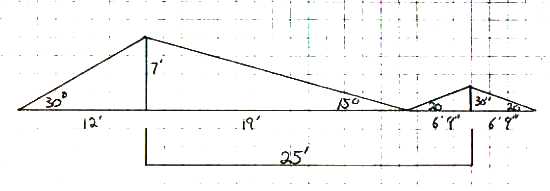
Reverse Ski Jump
Double and Triple Jumps Launch and Landing ramp angles
A.
Launching surface ramp angles are 30 degrees
B. Landings or Casing
surface ramp angles are 20, 15, & 10 degrees depending on the jumping
distance.
Triple Jumps
The take off jumping ramp is at or very near 30
degrees. The first landing jump (jump #2) has a 20 degree landing
ramp surface angle. The second landing jump (jump #3) has a 10
degree to 15 degree landing ramp surface angle.
The first jump has a standard height of 6 feet. The second jump has a standard height of 4 1/2 feet. And the third jump has a standard height of 3 feet.
A standard peak to peak triple jump distances are:
1. From the
first jump's peak to the second jump's peak is 40'
2. And from the
first jump's peak to the third jump's peak is 65' to 70'
However, in learning the triple jump that requires a lot of time and practice to be able to perform, I recommend a training triple to start with. Let's take a look.
The Training or Practice Triple Jump
The regular competition
distances can be applied into this jump if the riders' skill levels
display his ability to perform this jump.

2. Whop-de-dos

Calculation Slope Angles For Launching and Landing
Slope angels
are used to construct both the launching and landing ramps of any and all
jumps and whop-de-dos. The longer the jump the shallower the landing
slope. Most double jumps have both a 30 degree launching and landing
slope angle surface. Triple jumps have a 30 degree launching angle,
the second jump has a 20 degree landing angle, and the third jump has a 10
to 15 degree landing angle. Slope charts are prepared to construct
the jumps quicker, more accurately, and easily.
1. This first set of slope charts are for 10 degrees

This 10 degree Slope Chart goes out to 10' and up to 20"
high

This 10 degree Slope Chart goes out to 20' and up to 44"
high
2 . This second set of slope charts are for 15 degrees
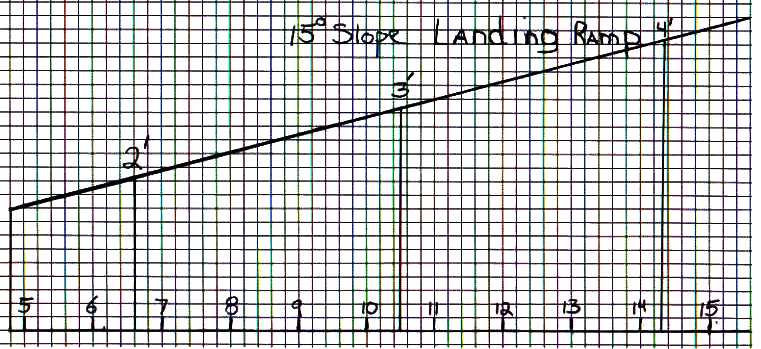
This 15 degree Slope Chart goes out to 15' and up to 54"
high
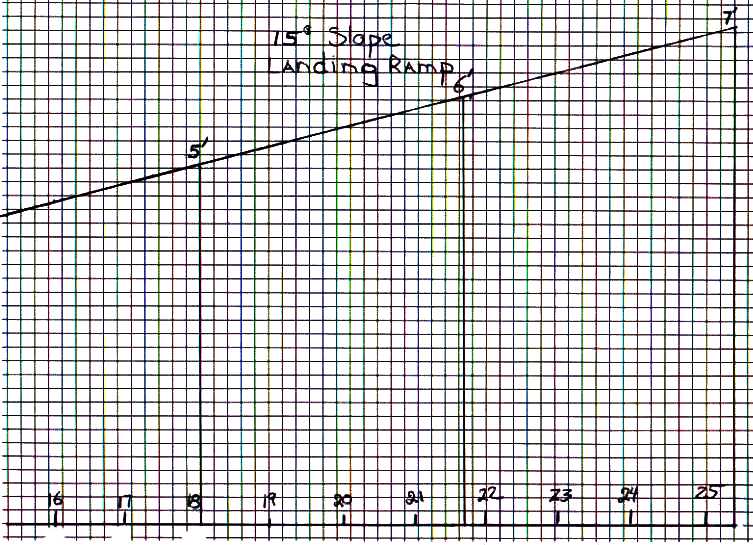
This 15 Degree Slope Chart goes out to 25' and up to 7'
high
3. This third set of slope charts are for 20 degrees

This 20 degree Slope Chart goes out to 10' and up to 45"
high

The 20 degree Slope Chart goes out to 20' and goes up to
7' high
4. This forth set of slope charts are for 30 degrees

This 30 degree Slope Chart goes out to 10' and up to 5'9"
high
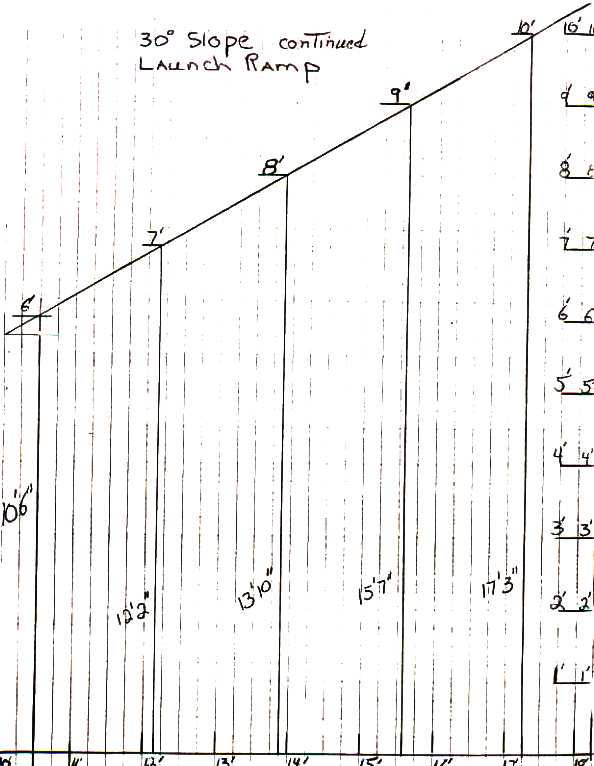
This 30 degree Slope Chart goes out to 18' and up to 10'
high
5. This fifth set of slope charts are for 35 degrees
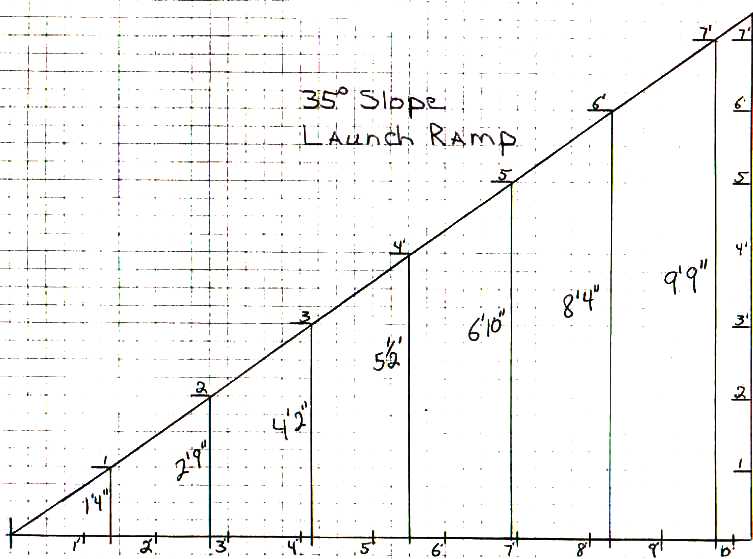
This 35 degree Slope Chart goes out to 10' and up to 7'
high
If you need slope calculations for any other slope angle please refer
to a trigonometry math book for the calculations of the needed slope
angle.
The following are actual Supercross tracks use in
Supercross events.
The typical
dimensions for the average stadium Supercross track are 200' x 400'
for the outside rectangular
border.
1. SX Track #1
2. SX Track #2
2. SX Track #3